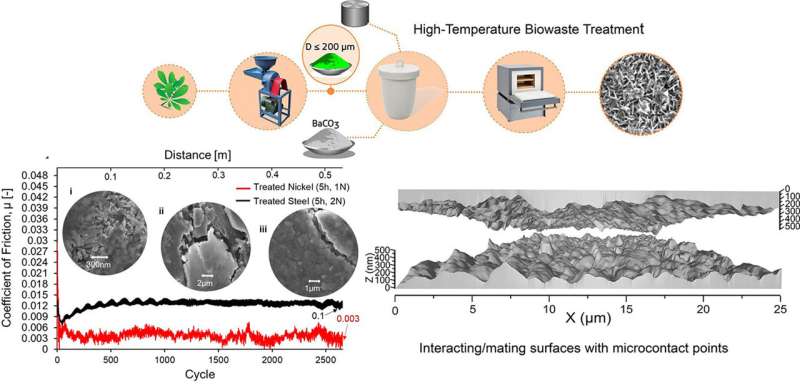This article has been reviewed according to Science X's editorial process and policies. Editors have highlighted the following attributes while ensuring the content's credibility:
fact-checked
proofread
Superlubricity study shows a frictionless state can be achieved at macroscale

The president of SUNY Polytechnic Institute (SUNY Poly), Dr. Winston "Wole" Soboyejo, and postdoctoral researcher Dr. Tabiri Kwayie Asumadu have published a paper titled, "Robust Macroscale Superlubricity on Carbon-Coated Metallic Surfaces." This paper explores an innovative approach to reducing friction on metallic surfaces—a significant advancement that could have major real-world impacts.
The research is published in the journal Applied Materials Today.
The study shows that superlubricity—a state with virtually no friction that was once believed to only be achievable at nanoscale—can now be maintained at macroscale for extended time periods, under regular atmospheric conditions, through employing sustainably produced carbon coatings made from biowaste.
These findings are significant for a number of practical reasons. In the automotive industry, more than 30% of fuel in passenger vehicles is used to overcome friction, so these novel coatings can help to drastically improve fuel efficiency. In manufacturing and industrial machinery, they could help to reduce wear and tear, leading to massive cost savings and decreasing the 1–4% of countries' GDP that is spent on friction-related equipment issues. In electronic devices, friction at a minute scale can present large-scale challenges that coatings could help to alleviate.
"This research truly could touch most industries," said Dr. Asumadu. "From biomedical to energy sectors to nearly every kind of manufacturing, this approach could help to extend the life of machine parts, reduce maintenance and replacement costs, and create a more sustainable industrial future."
This paper discusses experimental and computational results of ultralow (near-zero) friction of carbon-coated metallic depositions on substrates of structural steels, Ti, and Ni alloys. The macroscale superlubricity was demonstrated and sustained over several cycles through structurally misoriented carbon coatings on the metallic surfaces.
Carbon nanocrystals with variants of graphene footprints were deposited on these metallic surfaces using a novel high temperature biowaste treatment process. The carbon nanocrystals deform, flatten, and coalesce in the wear tracks to form graphitic films, leading to a superlubricious coefficient of friction of ~0.003.
A coating life of ~150,000 cycles with reduced wear rates was obtained on Ni and steel substrates. The experiments were validated with atomistic simulations providing mechanistic insights into the effects of the graphene variants on the observed frictionless conditions.
The underlying mechanisms of the coating/substrate interactions contributing to the macroscale superlubricity are elucidated. The implications of the current results are explored for designing robust and low-cost macroscale superlubricious carbon coatings on metallic substrates. Biowaste is a carbon source within a circular economy that uses material recycling to reduce the global carbon footprint.
The paper was published by a group of eight materials scientists collaborating across Africa and the Northeastern United States, including Mobin Vandadi, Desmond Edem Primus Klenam, Kwadwo Mensah-Darkwa, Emmanuel Gikunoo, Samuel Kwofie, and Nima Rahbar.
"My colleagues and I are extremely proud of this work, particularly for the environmental and economic implications it could have," said Dr. Soboyejo. "We look forward to seeing the breakthroughs in friction management technologies that will happen as researchers operationalize these approaches."
More information: Tabiri Kwayie Asumadu et al, Robust macroscale superlubricity on carbon-coated metallic surfaces, Applied Materials Today (2024). DOI: 10.1016/j.apmt.2024.102140
Provided by SUNY Polytechnic Institute



















